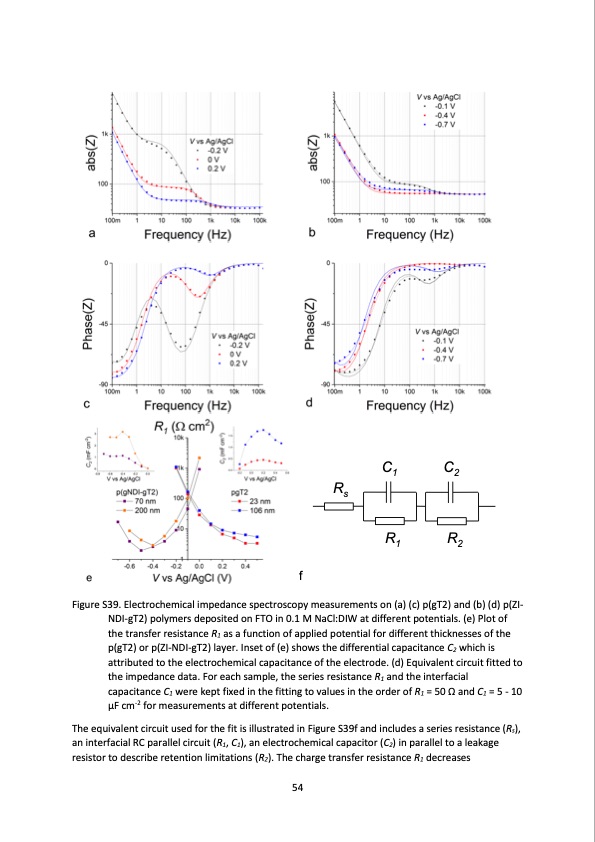
PDF Publication Title:
Text from PDF Page: 054
C1 C2 Rs R1 R2 Figure S39. Electrochemical impedance spectroscopy measurements on (a) (c) p(gT2) and (b) (d) p(ZI- NDI-gT2) polymers deposited on FTO in 0.1 M NaCl:DIW at different potentials. (e) Plot of the transfer resistance R1 as a function of applied potential for different thicknesses of the p(gT2) or p(ZI-NDI-gT2) layer. Inset of (e) shows the differential capacitance C2 which is attributed to the electrochemical capacitance of the electrode. (d) Equivalent circuit fitted to the impedance data. For each sample, the series resistance R1 and the interfacial capacitance C1 were kept fixed in the fitting to values in the order of R1 = 50 Ω and C1 = 5 - 10 μF cm-2 for measurements at different potentials. The equivalent circuit used for the fit is illustrated in Figure S39f and includes a series resistance (Rs), an interfacial RC parallel circuit (R1, C1), an electrochemical capacitor (C2) in parallel to a leakage resistor to describe retention limitations (R2). The charge transfer resistance R1 decreases 54 fPDF Image | salt water battery with high stability

PDF Search Title:
salt water battery with high stabilityOriginal File Name Searched:
salt-water-battery.pdfDIY PDF Search: Google It | Yahoo | Bing
Product and Development Focus for Salgenx
Redox Flow Battery Technology: With the advent of the new USA tax credits for producing and selling batteries ($35/kW) we are focussing on a simple flow battery using shipping containers as the modular electrolyte storage units with tax credits up to $140,000 per system. Our main focus is on the salt battery. This battery can be used for both thermal and electrical storage applications. We call it the Cogeneration Battery or Cogen Battery. One project is converting salt (brine) based water conditioners to simultaneously produce power. In addition, there are many opportunities to extract Lithium from brine (salt lakes, groundwater, and producer water).Salt water or brine are huge sources for lithium. Most of the worlds lithium is acquired from a brine source. It's even in seawater in a low concentration. Brine is also a byproduct of huge powerplants, which can now use that as an electrolyte and a huge flow battery (which allows storage at the source).We welcome any business and equipment inquiries, as well as licensing our flow battery manufacturing.| CONTACT TEL: 608-238-6001 Email: greg@salgenx.com | RSS | AMP |